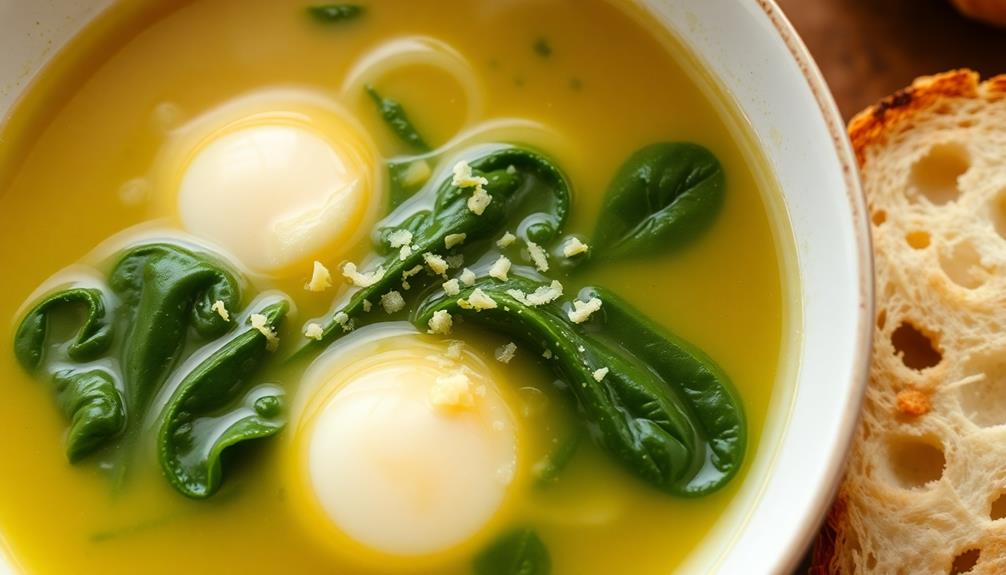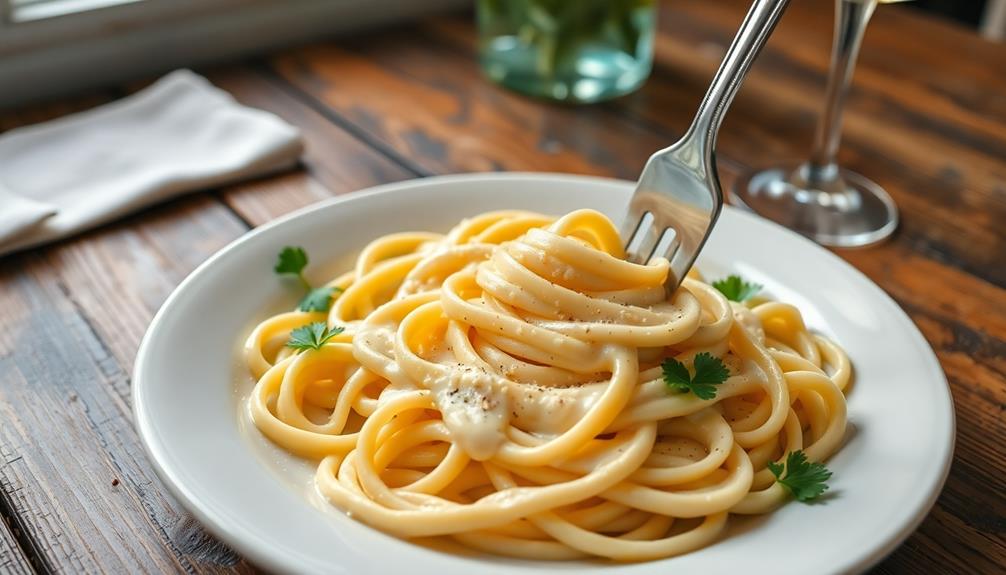Stracciatella soup is a beloved Italian classic that'll warm your soul on a chilly day! This savory broth with delicate egg strands and sprinkles of Parmesan cheese has comforted families for centuries. It's easy to make – just bring chicken broth to a gentle simmer, slowly whisk in beaten eggs, and finish with freshly grated cheese and spinach. The result is a nourishing, flavor-packed soup that's simply delightful. You'll love how the fragrant herbs and rich broth come together in every spoonful. Keep reading to uncover the fascinating history and cooking steps behind this irresistible dish!
Key Takeaways
- Stracciatella soup is a classic Italian dish that originated in ancient Rome as "stracciatella alla romana".
- It is a savory broth with egg drops and Parmesan cheese, often served as a comforting and nourishing meal.
- The name "stracciatella" refers to the shredded appearance of the egg in the broth.
- The soup is typically made with chicken or vegetable broth, eggs, Parmesan cheese, parsley, salt, and pepper.
- Stracciatella soup is a simple yet satisfying dish that is ideal for cool days or when feeling unwell.
History
The origins of stracciatella soup can be traced back to ancient Rome, where the dish was known as "stracciatella alla romana." This savory broth, featuring egg drops and Parmesan cheese, was a beloved comfort food among the city's residents.
Over time, the recipe traveled across the Italian peninsula, evolving and adapting to local ingredients and preferences.
By the 19th century, stracciatella had become a staple in Roman cuisine, often served as a simple, yet nourishing meal. The name "stracciatella" refers to the shredded or "torn" appearance of the egg drops that float in the clear broth. This unique texture and the blend of flavors made stracciatella a popular choice for both everyday dining and special occasions.
Today, this timeless soup continues to delight and nourish people around the world, remaining a cherished part of Italian culinary heritage.
Whether enjoyed as a starter or a light main course, stracciatella's comforting essence endures, connecting generations through the simple pleasure of a well-crafted dish.
Recipe
Stracciatella soup is a classic Italian dish that combines a flavorful broth with delicate ribbons of egg. This simple yet satisfying soup is a comforting and nourishing meal, perfect for cool days or when you're feeling under the weather. If you want to elevate your stracciatella soup experience, consider serving it with a side of crusty bread or a sprinkle of freshly grated Parmesan cheese. For a complete Italian meal, you can pair the soup with a traditional osso buco recipe, featuring tender braised veal shanks in a rich, flavorful sauce. Whether you enjoy it as a starter or a main dish, stracciatella soup is sure to become a beloved addition to your culinary repertoire.
The name "stracciatella" comes from the Italian word for "little rags," referring to the shredded or "stranded" appearance of the egg in the broth. The soup's origins can be traced back to the Roman cuisine, where it was traditionally served as a simple, homemade dish.
- Chicken or vegetable broth
- Eggs
- Parmesan cheese, grated
- Parsley, chopped
- Salt and pepper to taste
To prepare the soup, bring the broth to a gentle simmer in a large saucepan. In a small bowl, whisk the eggs and gradually drizzle them into the simmering broth, stirring constantly to create the stracciatella.
Stir in the Parmesan cheese and parsley, and season with salt and pepper to taste. Serve the soup hot, garnished with additional parsley if desired.
When making stracciatella soup, it's important to maintain a gentle simmer to prevent the egg from overcooking and becoming tough. Additionally, you can experiment with different garnishes, such as a sprinkle of chili flakes or a squeeze of lemon juice, to add depth of flavor to the dish.
Cooking Steps
First, bring the chicken broth to a gentle simmer.
Then, whisk the eggs right into the simmering broth to create those delicate strands.
Don't forget to stir in the Parmesan cheese shavings and fresh spinach leaves – it'll make your soup extra special!
Step 1. Bring Chicken Broth to a Simmer
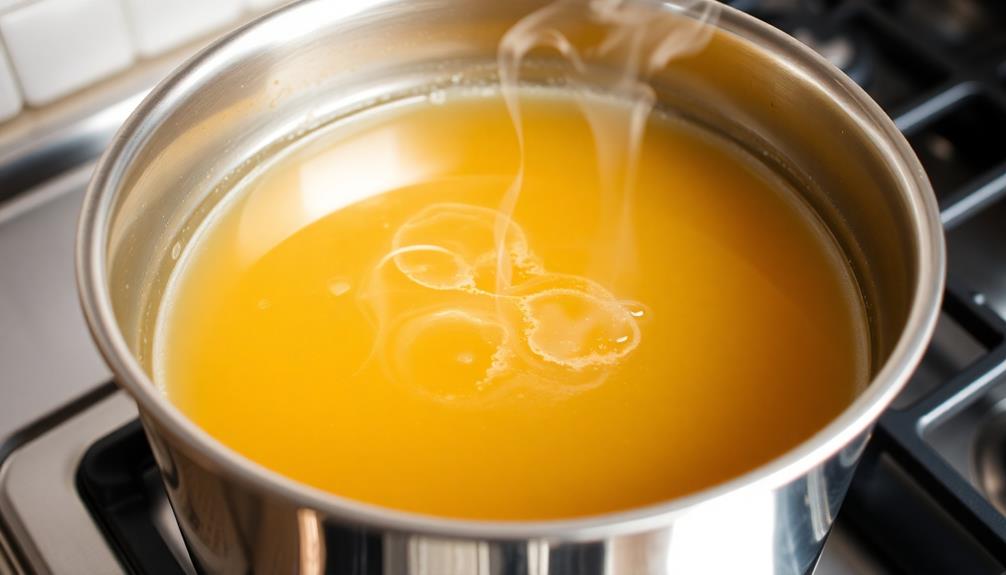
Bring a large pot of chicken broth to a gentle simmer over medium heat. You'll see tiny bubbles start to rise to the surface, but be careful not to let it come to a full boil. That's the perfect temperature for the next step!
Gently simmering the broth will allow all the flavors to meld together beautifully.
As the broth heats up, gather the remaining ingredients. You'll need:
- Beaten eggs
- Freshly grated Parmesan cheese
- Chopped parsley (for garnish)
Once the broth is simmering, it's time to add the egg mixture. Slowly drizzle in the beaten eggs while gently stirring the broth. This will create those lovely stracciatella (little egg drop) pieces floating in the soup.
Finish by sprinkling in the Parmesan and fresh parsley. Mmm, can you already smell the comforting aroma? Your Stracciatella Soup is well on its way!
Step 2. Whisk Eggs Into Simmering Broth
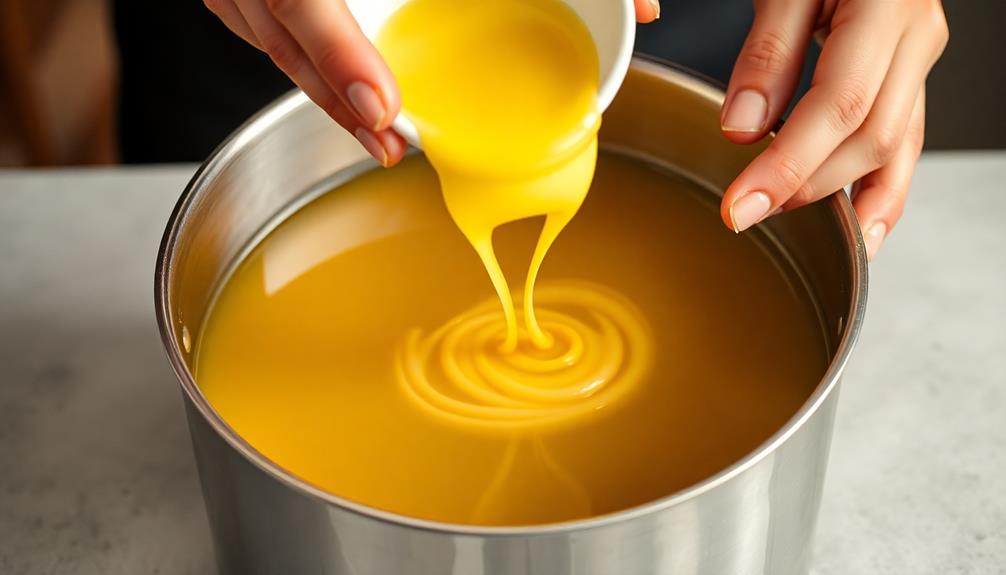
With the broth at a gentle simmer, slowly pour in the beaten eggs while continuously stirring the mixture. This technique is key to creating the delicate stracciatella, or "little rags," that give this soup its unique texture.
As the eggs hit the hot broth, they'll instantly start to cook and form delicate ribbons throughout. Keep whisking gently to ensure the eggs don't clump together. The result is a creamy, comforting soup with delightful pockets of eggy goodness in every spoonful.
Next, add a sprinkle of grated Parmesan cheese and some freshly chopped parsley or basil. The cheese will melt into the broth, adding a savory richness, while the herbs provide a bright, fresh flavor to balance out the dish.
Give the soup one final stir, then ladle it into bowls and serve immediately. The warm, nourishing broth and tender egg ribbons make this soup truly irresistible. Enjoy!
Step 3. Add Parmesan Cheese Shavings
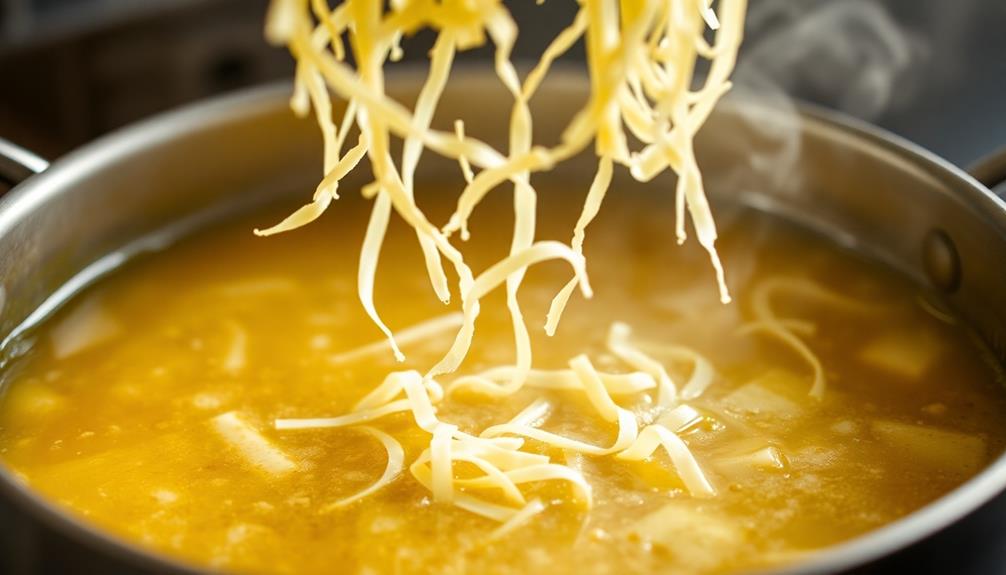
Next, sprinkle some grated Parmesan cheese over the soup. This adds a delightful savory flavor that complements the rich broth and tender egg strands.
Be generous with the cheese – a handful or two should do the trick! The Parmesan will melt into the hot soup, creating a creamy, cheesy goodness in every bite.
You can use freshly grated Parmesan for the best texture and taste. The shavings should be thin and lacy, floating on top of the soup.
As the Parmesan melts, it'll create a comforting, velvety finish. Stir the soup gently to incorporate the cheese.
The Parmesan's salty, nutty notes perfectly balance the delicate egg and mild broth. It's the finishing touch that takes this simple soup to new heights of flavor.
Get ready to enjoy a truly delicious and satisfying bowl of stracciatella!
Step 4. Stir in Spinach Leaves

After enjoying the savory Parmesan cheese, it's time to add some vibrant greenery to the soup. Grab a handful of fresh spinach leaves and gently stir them into the warm broth. Spinach isn't only a delicious addition but is also rich in vitamins A and C, which are essential for maintaining overall health beneficial for fetal development.
Watch as the leaves wilt down, their deep green hues infusing the soup with a nourishing boost of color and flavor. The spinach will provide a delightful contrast to the fluffy egg strands, adding a delicate, earthy touch.
As the leaves soften, they'll release their nutrients, enriching the broth with beneficial vitamins and minerals. Stir slowly, allowing the spinach to fully incorporate, ensuring each spoonful is brimming with wholesome goodness.
This simple addition of fresh greens transforms the stracciatella soup into a comforting, well-rounded meal. The spinach leaves will lend a pleasant texture and a dash of freshness, making every sip a true delight for your taste buds.
Step 5. Serve Immediately While Piping Hot
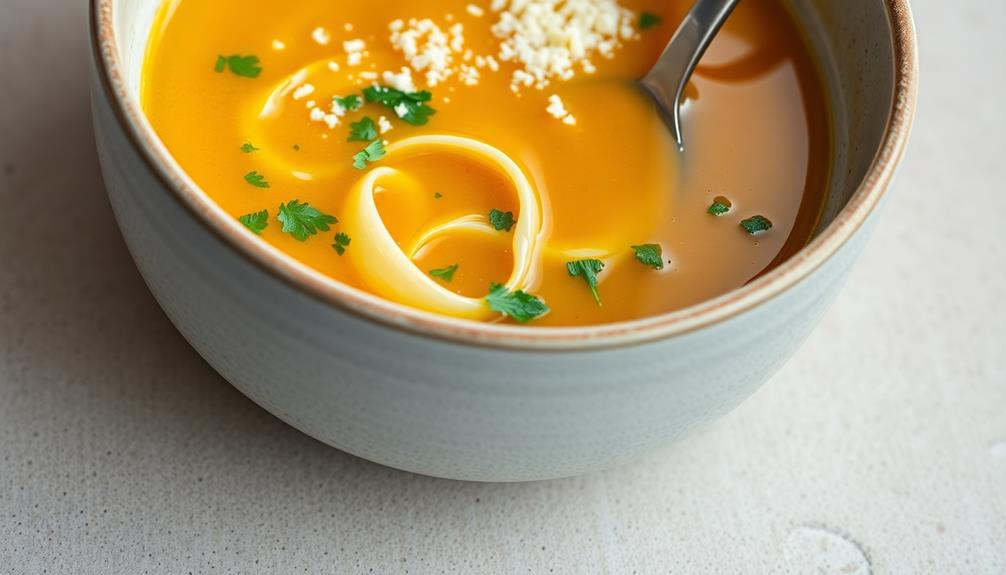
Once the spinach has wilted, it's time to ladle the stracciatella soup into bowls and serve it immediately while it's piping hot.
You'll want to work quickly to get this delicious soup to the table before it cools down. The steam rising from the bowls will have everyone's mouths watering in anticipation!
Be sure to use a ladle to scoop up plenty of the tender egg ribbons and savory broth.
Top each serving with a sprinkle of Parmesan cheese for a finishing touch. Your family will love the way the creamy, cheesy goodness melts in their mouths. The flavors are so comforting and satisfying, perfect for a chilly day.
Serve the stracciatella soup while it's fresh and hot, and enjoy watching your loved ones' faces light up with delight.
This is a dish that's sure to bring smiles all around. Don't wait – dive in and savor every last spoonful!
Final Thoughts
Stracciatella soup is a comforting and delightful dish that showcases the simplicity of quality ingredients. With its delicate, egg-dropped broth and tender greens, this soup is a true delight for the senses. When served piping hot, the warmth and nourishment it provides are unparalleled.
As you savor each spoonful, you'll be transported to a cozy kitchen, surrounded by the aroma of simmering broth and the gentle swirls of egg. The combination of flavors and textures is truly harmonious, leaving you feeling satisfied and content.
Whether you're enjoying a quiet evening at home or gathering with loved ones, this soup is sure to bring a smile to your face. Its simplicity belies the depth of flavor, making it a dish that can be appreciated by all.
Frequently Asked Questions
What Is the Origin of the Name "Stracciatella"?
The name "stracciatella" originates from the Italian word "straccio," meaning "rag" or "shred." It refers to the shredded or torn appearance of the egg drops in this classic Italian soup.
How Does Stracciatella Soup Differ From Other Egg-Drop Soups?
Stracciatella soup differs from other egg-drop soups by its unique ingredients and preparation process. Instead of simply dropping beaten eggs into the broth, it features a parmesan and egg mixture that's gently stirred into the hot liquid, creating delicate ribbons.
Can Stracciatella Soup Be Made With Alternative Protein Sources?
You certainly can make stracciatella soup with alternative protein sources. Instead of eggs, you could use tofu, chicken, or even plant-based meat substitutes to create a delicious and protein-packed version of this classic dish.
What Is the Best Way to Achieve the Desired Egg-Drop Texture?
To achieve the desired egg-drop texture, slowly drizzle the beaten eggs into the simmering broth while stirring gently. This creates strands of cooked egg that mimic the traditional stracciatella style.
How Long Can Stracciatella Soup Be Stored For?
You can store stracciatella soup for up to 3-4 days in the refrigerator. It's best to keep it in an airtight container to prevent it from drying out or losing its flavor. Enjoy your soup within this time frame for the best taste and texture.
